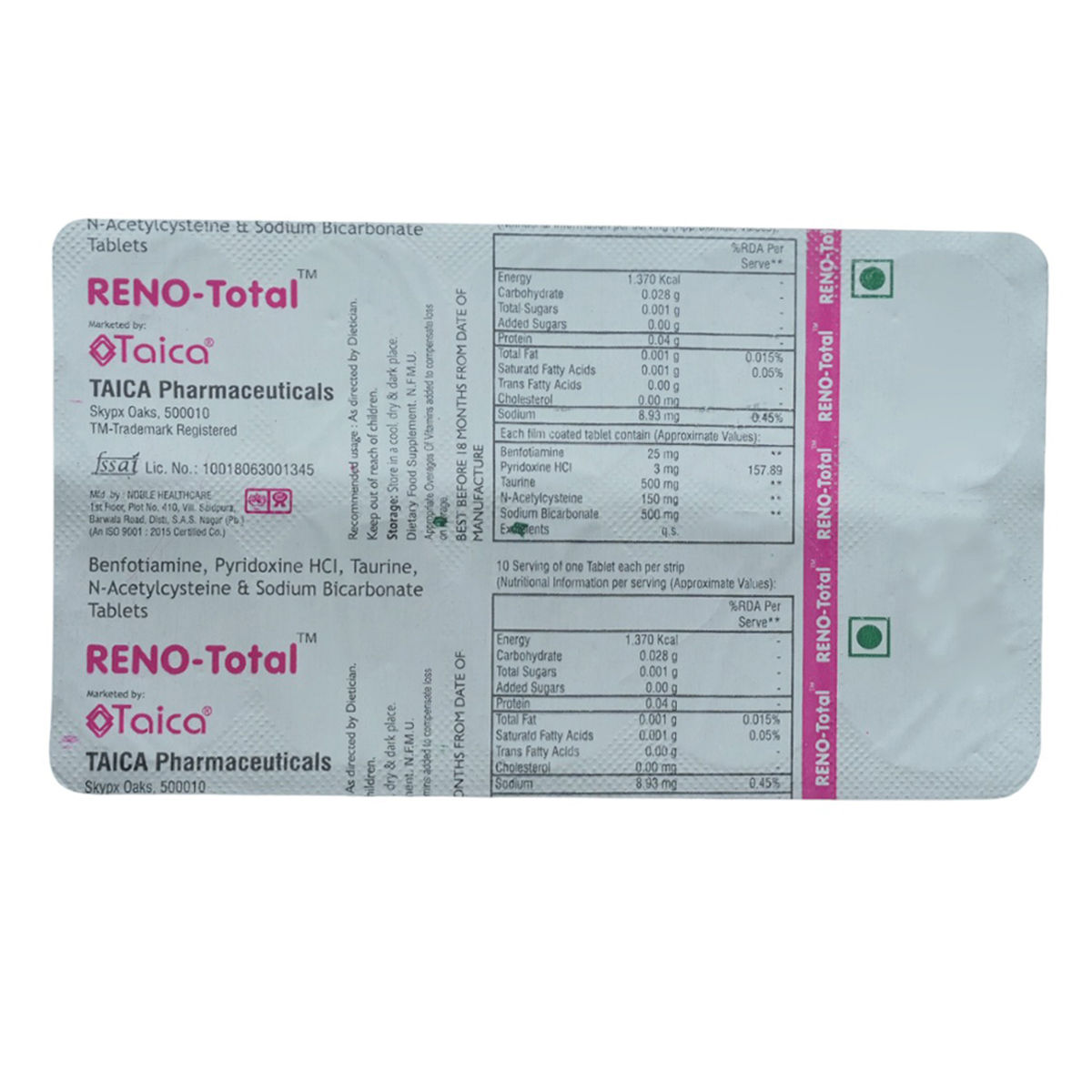Pyridoxine+acetylcysteine
About Pyridoxine+acetylcysteine
Pyridoxine+acetylcysteine belongs to the class of 'nutritional supplements' primarily used to treat, improve, control, and prevent various complications or long-term diseases. It is used to treat anaemia, respiratory illnesses, brain, and spinal cord disorders, heart diseases, kidney diseases, skin problems, hormonal disorders, and immune system problems.
Pyridoxine+acetylcysteine is a combination of two medicines: Pyridoxine and Acetylcysteine. Pyridoxine (vitamin B6) acts as a coenzyme essential for the metabolism of protein, carbohydrates, and fats. Acetylcysteine converts into L-cysteine in the body, which is essential for the production of proteins. It also has antioxidant and anti-inflammatory properties.
You should take this medicine as prescribed by your doctor. Pyridoxine+acetylcysteine may cause side-effects such as nausea (feeling sick), vomiting (being sick), rash, itching, upset stomach, and drowsiness. It may also cause numbness or pricking sensation in the hands and feet if large doses are taken. These side-effects are mild and temporary. However, inform your doctor if any of these side-effects persist or worsen.
Do not take Pyridoxine+acetylcysteine if you are allergic to Pyridoxine, Acetylcysteine, or any ingredients present in it. It is not recommended for use in children. Before taking Pyridoxine+acetylcysteine, inform your doctor if you have asthma, stomach ulcers, liver, or kidney diseases, and allergic to histamine (in people who are intolerant to foods and drinks containing histamines such as tomatoes, processed foods, or wine). Also, inform your doctor if you are pregnant or breastfeeding.
Uses of Pyridoxine+acetylcysteine
Medicinal Benefits
Pyridoxine+acetylcysteine is a combination of two medicines: Pyridoxine and Acetylcysteine. Pyridoxine (vitamin B6) replenishes the deficient vitamin B6 in the body. It acts as a coenzyme essential for the metabolism of protein, carbohydrates, and fats. Acetylcysteine converts into L-cysteine in the body, which is essential for producing proteins. It has antioxidant properties and protects the cells from damage. It also has anti-inflammatory properties.
Directions for Use
Storage
Side Effects of Pyridoxine+acetylcysteine
- Nausea (feeling sick)
- Vomiting (being sick)
- Diarrhea
- Abdominal discomfort
- Rash
- Itching
- Upset stomach
- Drowsiness
- Numbness of hands and feet (if taken in large doses)
Drug Warnings
Pyridoxine+acetylcysteine should be used with caution in patients with decreased lung function (asthma or chronic obstructive pulmonary disease), and stomach ulcers. Do not use Pyridoxine+acetylcysteine more than recommended as this medicine may cause peripheral neuritis (damage to the nerves present outside the brain and spinal cord) in large doses. Pyridoxine+acetylcysteine increases the risk of Steven-Johnson syndrome and Lyell syndrome which are characterized by severe skin rashes. So, stop taking this medication and consult your doctor immediately if you notice skin rashes, ulcers in the mouth, throat, nose, or genitals, or conjunctivitis (pink eye), followed by flu-like symptoms such as fever, headache, and body ache.
Drug Interactions
Drug-drug interactions: Pyridoxine+acetylcysteine may interact with a medication used to treat Parkinson’s disease (levodopa), a medication used to treat tuberculosis (isoniazid), medications used to treat cough, a medicine used to treat poisonings (activated charcoal), birth control pills, a medication used to treat arthritis (penicillamine), aminoglycoside antibiotics (gentamicin, streptomycin, tobramycin, and amikacin, etc.), other antibiotics (penicillin and tetracycline), and medicine used to treat chest pain (glyceryl trinitrate).
Drug-food interactions: No interactions found.
Drug-disease interactions: Pyridoxine+acetylcysteine should be used with caution in patients with asthma, stomach ulcers, liver disease, kidney disease, and allergic to histamines.
Drug-Drug Interactions Checker List:
Safety Advice

Alcohol
cautionConsumption of alcohol may worsen your health condition.

Pregnancy
cautionPyridoxine+acetylcysteine is a category B medicine. So, it should be used with caution in pregnant women. Your doctor will weigh the benefits and any potential risks before prescribing it to you. Please consult your doctor.

Breast Feeding
cautionPyridoxine+acetylcysteine should be used with caution in breastfeeding mothers. Your doctor will weigh the benefits and any potential risks before prescribing it to you. Please consult your doctor.

Driving
safe if prescribedPyridoxine+acetylcysteine may not affect your ability to drive.

Liver
cautionPyridoxine+acetylcysteine should be used with caution in patients with liver diseases. Dose adjustments may be necessary.

Kidney
cautionPyridoxine+acetylcysteine should be used with caution in patients with kidney diseases. Dose adjustments may be necessary. Please consult your doctor.

Children
unsafePyridoxine+acetylcysteine is not recommended for use in children.
Habit Forming
Diet & Lifestyle Advise
- Try Vitamin B complex food sources like milk, cheese, eggs, liver and kidney, chicken, red meat, tuna, mackerel, and salmon, shellfish, oysters, clams, dark green vegetables, such as spinach and kale, beets, avocados, and potatoes, whole grains, cereals, kidney beans, black beans, and chickpea.
- Avoid smoking and alcohol consumption.
- Exercise regularly, and maintain a healthy lifestyle. Avoid excess fatty foods.
Special Advise
Pyridoxine+acetylcysteine may alter blood results when the test for salicylic acid (aspirin) is performed. It may also alter results when tested for the presence of ketones in the urine.
Patients Concern
Disease/Condition Glossary
Nutritional deficiencies: A nutritional deficiency occurs when the body does not absorb or get enough nutrients from food. Many nutrients are essential for a healthy life. Sometimes your body is unable to absorb many nutrients even if you are consuming them. Nutrient deficiency can lead to many health problems like a weakened immune system, skin problems, heart problems, kidney diseases, respiratory illnesses, or neurological diseases.
FAQs
Pyridoxine+acetylcysteine is used to treat, improve, control, and prevent various complications or long-term diseases. It is used to treat anaemia, respiratory illnesses, brain, and spinal cord disorders, heart diseases, kidney diseases, skin problems, hormonal disorders, and immune system problems.
Pyridoxine+acetylcysteine is a combination of two medicines: Pyridoxine and Acetylcysteine. Pyridoxine+acetylcysteine acts as a nutritional supplement. It helps in the formation of proteins in the body that are essential for vital functions. It also has antioxidant and anti-inflammatory properties that can improve various conditions.
Pyridoxine+acetylcysteine is well-tolerated when taken in recommended doses. However, some patients may experience mild and temporary side-effects such as nausea (feeling sick), vomiting (being sick), rash, itching, upset stomach, and drowsiness. If taken in large doses, Pyridoxine+acetylcysteine may cause numbness or pricking sensation in the hands and feet.
It is not recommended to smoke while taking Pyridoxine+acetylcysteine as it may reduce the effectiveness of Pyridoxine+acetylcysteine. It decreases your ability to fight the disease, causing disease progression, and worsening the health condition.
Pyridoxine+acetylcysteine may cause severe skin reactions in rare cases. However, if you notice a skin rash, including lesions of the nose, throat, mouth, genitals, or eyes, stop taking Pyridoxine+acetylcysteine and consult a doctor immediately.
It is not recommended to take Pyridoxine+acetylcysteine with antibiotics such as tetracycline, amoxicillin, amikacin, streptomycin, and gentamicin simultaneously as it may reduce the effectiveness of antibiotics. Please consult a doctor before using Pyridoxine+acetylcysteine with antibiotics or any other medicines.
Take Pyridoxine+acetylcysteine for as long as your doctor has prescribed it. Your doctor may recommend it for a short-term or long-term duration based on your medical condition. Do not take it for longer than the prescribed duration, as doing so may lead to side effects.
Do not take Pyridoxine+acetylcysteine for a fever and cold without consulting your doctor. Although Pyridoxine+acetylcysteine helps break down mucus and improve respiratory function (due to Acetylcysteine) and support immune function (due to Pyridoxine), it is best to consult with a doctor to ensure that this medication is appropriate for your symptoms.
Do not stop taking Pyridoxine+acetylcysteine without consulting your doctor, even if you feel better. Stopping the medication too early could affect your recovery. Always consult your doctor before making any changes to your treatment.
Pyridoxine+acetylcysteine should be used with caution during pregnancy. Your doctor will assess the benefits and potential risks before prescribing it to you.
If you miss a dose of Pyridoxine+acetylcysteine, take it as soon as you remember unless it is close to the time for your next dose. Do not double the dose to make up for the missed one.
It is generally safe to take antacids with Pyridoxine+acetylcysteine, as there are no known major interactions. However, antacids can affect the absorption of some medications, so it is best to space them out by at least 1-2 hours. Always consult with your doctor to ensure it is appropriate for your specific situation.
Pyridoxine+acetylcysteine typically begins to work within a few hours to a few days, depending on the condition being treated. However, noticeable relief may take longer, depending on whether the condition requires short-term or long-term treatment. Please consult your doctor for personalized guidance.




